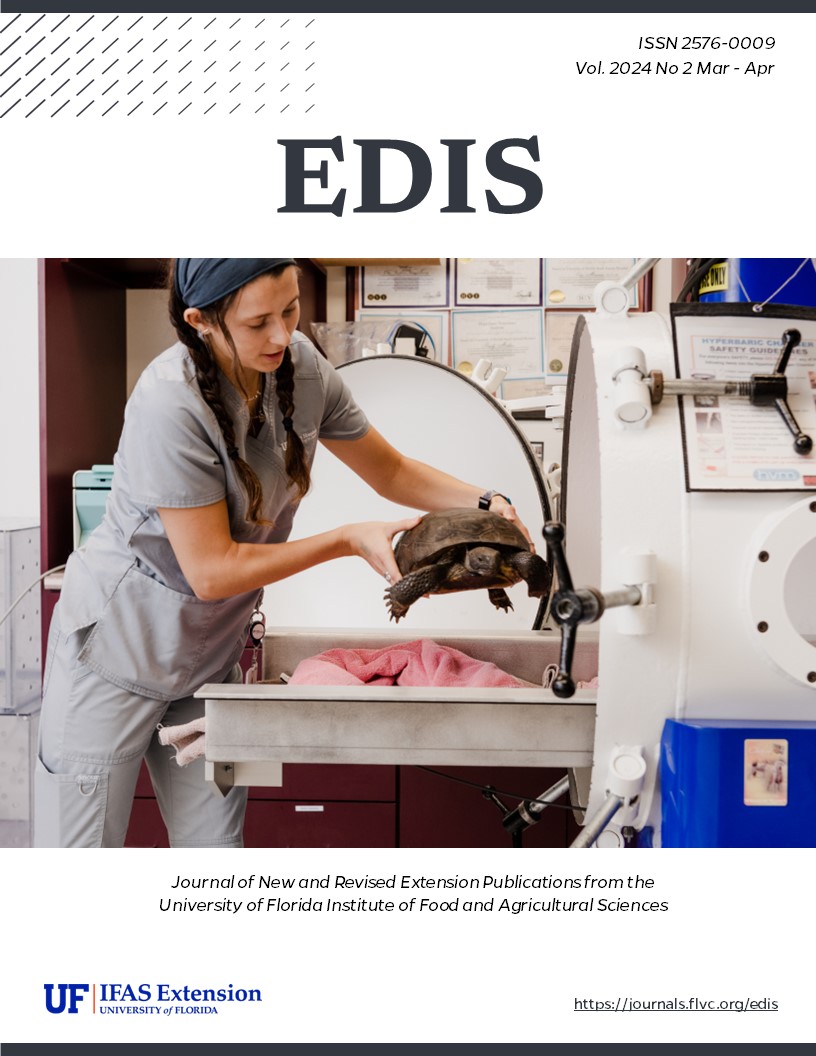Abstract
The blueberry gall midge (BGM) is one of the most important pests of southern highbush blueberries in Florida. Monitoring for BGM using clear sticky traps or bucket traps should begin as early as November. Chemical control should be applied right before bud break and then ten days after bud break, or when at least two BGM are found on traps. Other management practices include the use of younger mulch, using potentially resistant cultivars, and chemical control such as Movento with Induce and Apta in rotation to avoid resistance development. Applications should also be timed with larval and adult emergence for optimal insecticide efficacy.
References
Biddinger, D. J., T. W. Leslie, and N. K. Joshi. 2014. “Reduced-Risk Pest Management Programs for Eastern U.S. Peach Orchards: Effects on Arthropod Predators, Parasitoids, and Select Pests.” Journal of Economic Entomology. 107 (3). 1084–1091. https://doi.org/10.1603/EC13441.
Bosio, G., C. Bogetti, G. Brussino, F. Gremo, and F. Scarpelli. 1998. “Dasineura oxycoccana, A New Pest of Blueberry in Italy.” Informatore Fitopatologico. 11: 36–41.
Dernisky, A. K., R. C. Evans, O. E. Liburd, and K. MacKenzie. 2005. “Characterization of Early Floral Damage by Cranberry Tipworm (Dasineuraoxy coccana Johnson) as a Precursor to Reduced Fruitset in Rabbiteye Blueberry (Vaccinium ashei Reade).” Internation Journal of Pest Management. 51(2): 143–148. https://doi.org/10.1080/09670870500130980.
Gardner, J., M. P. Hoffmann, S. A. Pitcher, and J. K. Harper. 2011. “Integrating Insecticides and Trichogramma ostriniae to Control European Corn Borer in Sweet Corn: Economic Analysis.” Biological Control. 56 (1) 9–16. https://doi.org/10.1016/j.biocontrol.2010.08.010.
Gentz, M .C., G. Murdoch, and G. F. King. 2010. “Tandem Use of Selective Insecticides and Natural Enemies for Effective, Reduced-Risk Pest Management. Biological Control. 52 (3) 208–215. https://doi.org/10.1016/j.biocontrol.2009.07.012.
Grover, P. 1986. “Integrated Control of Midge Pests.” Cecidologia-Internationale. 7: 1–28.
Hahn N. G. Isaacs R. 2012. “Distribution and Phenology of Dasineura oxycoccana (Diptera: Cecidomyiidae) in Michigan Blueberries.” Environmental Entomology. 41: 455–462. https://doi.org/10.1603/EN12002.
Insecticide Resistance Action Committee (IRAC). 2018. “The IRAC Mode of Action Classification Online.” 9.1. https://irac-online.org/modes-of-action/
Joshi, N. K., T. Leslie, E. G. Rajotte, and D. J. Biddinger. 2020. "Environmental impacts of reduced-risk and conventional pesticide programs differ in commercial apple orchards, but similarly influence pollinator community.” Chemosphere. 240. 124926. https://doi.org/10.1016/j.chemosphere.2019.124926.
Liburd, O. E. and D. Phillips. 2019. “Blueberry Gall Midge on Southern Highbush Blueberry in Florida: IN1239/ ENY-997.”EDIS. https://doi.org/10.32473/edis-in1239-2019.
Lopez, M. n.d. “[Title forthcoming]”. Unpublished PhD diss., University of Florida.
Lyrene, P. and J.A. Payne. 1992. ”Blueberry Gall Midge: A Pest on Rabbiteye Blueberry in Florida.” Proceedings, Florida State Horticultural Society. 105: 297–300.
Lyrene, P. M. and J.A. Payne. 1996. “Blueberry Gall Midge: A New Pest of Rabbiteye Blueberries.” Journal of Small Fruit and Viticulture. 2-3: 111–124. https://doi.org/10.1300/J065v03n02_12.
Peach, D. A. H., J. T. Huber, and S. M. Fitzpatrick. 2012. “Hymenopterous Parasitoids of Cranberry Tipworm (Diptera: Cecidomyiidae) in British Columbia, Canada.” The Canadian Entomologist. 144(3): 487–490. https://doi.org/10.4039/tce.2012.37.
Phillips, Doug, Jeffrey Williamson, James Olmstead, and Paul Lyrene. 2020. “Reproductive Growth and Development of Blueberry: HS976/HS220, Rev. 3/2020”. EDIS 2020 (2). https://doi.org/10.32473/edis-hs220-2020.
Rhodes, E. M., N. D. Benda, and O. E. Liburd. 2014. “Field Distribution of Dasineura oxycoccana (Diptera: Cecidomyiidae) Adults, Larvae, Pupae, and Parasitoids and Evaluation of Monitoring Trap Designs in Florida.” Journal of Economic Entomology. 107 (1). 310–318. https://doi.org/10.1603/EC13409.
Roubos C. R. Liburd O. E. 2010. “Evaluation of Emergence Traps for Monitoring Blueberry Gall Midge (Diptera: Cecidomyiidae) Adults and within Field Distribution of Midge Infestation.” Journal of Economic Entomology. 103(4): 1258–1267. https://doi.org/10.1603/EC09317.
Roubos, C. R., and O. E. Liburd. 2013. “Parasitism of Dasineura oxycoccana (Diptera: Cecidomyiidae) in North Central Florida.” Environmental Entomology. 42(3): 424–429. https://doi.org/10.1603/EN12307.
Sampson, B. J., C. R. Roubos, S. J. Stringer, D. Marshall, O. E. Liburd. 2013. “Biology and Efficacy of Aprostocetus (Eulophidae: Hymenoptera) as a Parasitoid of the Blueberry Gall Midge Complex: Dasineura oxycoccana and Prodiplosis vaccinii (Diptera: Cecidomyiidae).” Journal of Economic Entomology. 106 (1) 73–79. https://doi.org/10.1603/EC12404.
Sampson, B. J., S. J. Stringer, J. M. Spiers. 2002. “Integrated Pest Management for Dasineura oxycoccana (Diptera: Cecidomyiidae) in Blueberry.” Environmental Entomology. 31 (2): 339–347. https://doi.org/10.1603/0046-225X-31.2.339
Spiers, J. M. 1978. “Effect of Stage of Bud Development on Cold Injury in Rabbiteye Blueberry.” Journal of the American Society for Horticultural Science. 103(4): 452–455. https://doi.org/10.21273/JASHS.103.4.452.
Steck, G. J., P. M. Lyrene, and J. A. Payne. 2000. “Blueberry Gall Midge, Dasineura oxycoccana (Johnson) (Insecta: Diptera: Cecidomyiidae).” DPI Entomology Circular 373. Publication EENY136. http://entnemdept.ufl.edu/creatures/fruit/blueberry_gall_midge.htm.
United States Environmental Protection Agency (EPA). 2023. “Conventional Reduced-Risk Pesticide Program.” https://www.epa.gov/pesticide-registration/conventional-reduced-risk-pesticide-program.

This work is licensed under a Creative Commons Attribution-NonCommercial-NoDerivatives 4.0 International License.
Copyright (c) 2024 UF/IFAS


